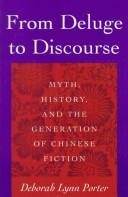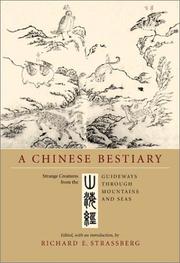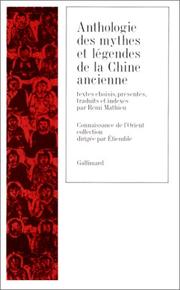| Listing 1 - 10 of 20 | << page >> |
Sort by
|
Book
ISBN: 9782842795467 9782842793920 Year: 2010 Publisher: Paris : Editions You Feng,
Abstract | Keywords | Export | Availability | Bookmark
 Loading...
Loading...Choose an application
- Reference Manager
- EndNote
- RefWorks (Direct export to RefWorks)
Book
Year: 1971 Publisher: Lochem : De Tijdstroom,
Abstract | Keywords | Export | Availability | Bookmark
 Loading...
Loading...Choose an application
- Reference Manager
- EndNote
- RefWorks (Direct export to RefWorks)
Book
ISBN: 9782296027244 2296027245 Year: 2007 Publisher: Paris: L'Harmattan,
Abstract | Keywords | Export | Availability | Bookmark
 Loading...
Loading...Choose an application
- Reference Manager
- EndNote
- RefWorks (Direct export to RefWorks)
Mythology, Chinese --- Contes --- Mythologie chinoise --- Création
Book
ISBN: 9782842791223 2842791223 Year: 2002 Publisher: Paris : Editions You-Feng,
Abstract | Keywords | Export | Availability | Bookmark
 Loading...
Loading...Choose an application
- Reference Manager
- EndNote
- RefWorks (Direct export to RefWorks)
Mythology, Chinese --- Legends --- Gods, Chinese. --- Mythologie chinoise --- Dieux chinois

ISBN: 0585075190 9780585075198 0791430332 0791430340 1438416342 9781438416342 Year: 1996 Publisher: Albany, New York : State University of New York Press,
Abstract | Keywords | Export | Availability | Bookmark
 Loading...
Loading...Choose an application
- Reference Manager
- EndNote
- RefWorks (Direct export to RefWorks)
Starting with a reevaluation of the critical scholarship done on the Chinese text, the "Mu T'ien-tzu chuan", the author challenges the view of the text as a product of historical composition. Porter then argues that the discursive structures of flood myths, elements of which appear in the "Mu T'ien-tzu chuan", have their origins in an attempt to mediate linguistically the frightening consequences of the falsification of cosmological truths. The heuristic potential of the psychoanalytical theory of the symbol is used to explain the specific cosmogonic intentions underlying the genesis of myth, as well as broader manifestations of historical, social, and cultural behavior, most particularly literary works like the "Mu T'ien-tzu chuan", The author explains how mythic symbols invested with cosmogonic and regenerative significance are appropriated in the literary resolution of a socio-political trauma analogous to those mediated by flood myths. Finally, she argues that not simply the "Mu T'ien-tzu chuan" but Chinese fictional discourse in general is most appropriately understood as a wholly symbolic form. "Not only does this book remedy major shortcomings of previous research on the "Mu T'ien-tzu chuan" in terms of textual criticism, bilbiography, and methodology, it also lays to rest the view of the text as a product of historical composition. This by itself would be a worthwhile contribution to Sinological scholarschip. But for the author this is only the starting point for a "tour de force" of literary and philological analysis of a problematical text in which a remarkable array of evidence is mobilized in establishing that the "Mu T'ien-tzu chuan is the linguistic expression of a symbolic operation : " a tale of crisis, of its collective transcendence, of the symbols that emanated from it, and of the memory that preserved it"". David W. Pankenier, Lehigh University.
Mythology, Chinese. --- Legends --- Chinese fiction --- Chinese mythology --- History and criticism. --- Mythologie chinoise.
Book
ISBN: 9791036504396 2760625176 276062076X Year: 2007 Publisher: Montréal [Que.] : Presses de l'Université de Montréal,
Abstract | Keywords | Export | Availability | Bookmark
 Loading...
Loading...Choose an application
- Reference Manager
- EndNote
- RefWorks (Direct export to RefWorks)
Si les mythes de la Chine ancienne sont encore aujourd'hui mal connus, c'est sans doute parce que les grandes écoles de pensée comme le confucianisme les tenaient en suspicion. Le Maître n'évoquait pas volontiers les légendes et les esprits, sinon pour dire qu'il fallait les garder à distance. En fait, contrairement au monde gréco-romain, la Chine n'a pas reconnu comme tels ses propres mythes, même dans les textes qui en font amplement usage. À tel point qu'on a pu se demander s'il avait existé une mythologie chinoise au sens où on l'entend généralement en Occident. Les récits qui sont parvenus jusqu'à nous sont dispersés dans des ouvrages appartenant à des domaines très différents, et qui ne permettent pas d'en découvrir facilement l'origine ou la signification. Les textes réunis dans cet ouvrage unique viennent jeter un éclairage nouveau sur les rapports de quelques grands mythes anciens avec l'histoire et la philosophie chinoises.
Mythology, Chinese. --- Mythologie chinoise. --- Electronic books. --- Chinese mythology --- Books in machine-readable form --- Digital books --- E-books --- Ebooks --- Online books --- Books --- Electronic publications --- mythologie chinoise --- pensée chinoise --- Chine ancienne
Multi
ISBN: 9789042929104 9042929103 Year: 2013 Volume: 460 13 Publisher: Louvain Paris Walpole, MA Peeters
Abstract | Keywords | Export | Availability | Bookmark
 Loading...
Loading...Choose an application
- Reference Manager
- EndNote
- RefWorks (Direct export to RefWorks)
Folklore --- Ethnobotany --- Mulberry --- Mythology, Chinese --- Ethnobotanique --- Mûriers --- Mythologie chinoise --- History --- Histoire --- Mûriers --- China --- Symbolic aspects --- To 500
Book
ISBN: 3631327765 Year: 1998 Publisher: Frankfurt am main Bern New York Peter Lang
Abstract | Keywords | Export | Availability | Bookmark
 Loading...
Loading...Choose an application
- Reference Manager
- EndNote
- RefWorks (Direct export to RefWorks)

ISBN: 0520218442 9780520218444 Year: 2002 Publisher: Berkeley: University of California press,
Abstract | Keywords | Export | Availability | Bookmark
 Loading...
Loading...Choose an application
- Reference Manager
- EndNote
- RefWorks (Direct export to RefWorks)
'A Chinese Bestiary 'presents a fascinating pageant of mythical creatures from a unique and enduring cosmography written in ancient China. The 'Guideways through Mountains and Seas, 'compiled between the fourth and first centuries b.c.e., contains descriptions of hundreds of fantastic denizens of mountains, rivers, islands, and seas, along with minerals, flora, and medicine. The text also represents a wide range of beliefs held by the ancient Chinese. Richard Strassberg brings the 'Guideways 'to life for modern readers by weaving together translations from the work itself with information from other texts and recent archaeological finds to create a lavishly illustrated guide to the imaginative world of early China. Unlike the bestiaries of the late medieval period in Europe, the 'Guideways 'was not interpreted allegorically the strange creatures described in it were regarded as actual entities found throughout the landscape. The work was originally used as a sacred geography, as a guidebook for travelers, and as a book of omens. Today, it is regarded as the richest repository of ancient Chinese mythology and shamanistic wisdom. The 'Guideways 'may have been illustrated from the start, but the earliest surviving illustrations are woodblock engravings from a rare 1597 edition. Seventy-six of those plates are reproduced here for the first time, and they provide a fine example of the Chinese engraver's art during the late Ming dynasty. This beautiful volume, compiled by a well-known specialist in the field, provides a fascinating window on the thoughts and beliefs of an ancient people, and will delight specialists and general readers alike.
Mythology, Chinese. --- Folklore --- Mythologie chinoise --- Mythology, Chinese --- China --- Description and travel --- Description and travel. --- Chinese mythology --- Folklore - China --- China - Description and travel

ISBN: 2070716775 9782070716777 Year: 1989 Volume: 69 Publisher: [Paris]: Gallimard,
Abstract | Keywords | Export | Availability | Bookmark
 Loading...
Loading...Choose an application
- Reference Manager
- EndNote
- RefWorks (Direct export to RefWorks)
Mythology [Chinese ] --- Legends --- China --- Mythology, Chinese --- Légendes --- Mythologie chinoise --- S16/0475 --- China: Literature and theatrical art--Popular literature (incl. fairy tales, legends)
| Listing 1 - 10 of 20 | << page >> |
Sort by
|

 Search
Search Feedback
Feedback About UniCat
About UniCat  Help
Help News
News